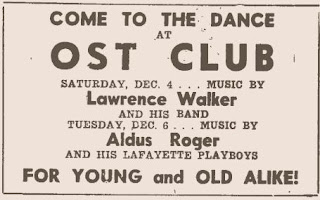In the early days, I played with a lot of well-known musicians. Among them were Joe Fabacher, Joe Falcon, Lawrence Walker, Blackie Alleman, Lester Hoffpauir and many others.1
Hillbilly singing was rapidly rising in popularity in the Depression days of the early 30s, but the majority of the music was played individually. When Happy organized his band, it was one of the first all-hillbilly bands in the United States.1
Je suis venu à Saint Martin pour voir les belles 'tites filles,C'est dommage (qu'elles) sont si canailles , (il) y a pas manière, (mon coeur)*.'Gardez-donc, jolie 'tite fille, ça t'as fait avec moi,Te connais, malheureuse, j'veux pas (ta coeur ca autant)*.Je t'ai demandé si tu m'aimais, toi jolie 'tite fille,Tu m'as dit "non", malheureuse, et ça, ça m'fais du mal.
 |
| Daily Advertiser Jun 1, 1935 |
"Le Fille De St. Martin" (#2172) was an ode to a lover living St Martin parish. Recorded in New Orleans in 1935, it's considered Happy Fats' very first professional recording he ever wrote. It would kick off an almost 40 year recording career for the young hillbilly singer. During the late 40s, songs such as this and Fuselier's "Lake Arthur Stomp" inspired other tunes like Floyd Leblanc's "Louisiana Stomp" and Harry Choates "Fa De Do Stomp". However, the melody seems to be one of the founding sources for the zydeco song known as "Jolie Catin", later recorded by people such as Boozoo Chavis and John Delafose. In the 1950s, Happy recalled those early years. ,
The first song I ever wrote was called "La Fille De St. Martin". Since then, I guess I've written about 150 songs all together.1
I came to St. Martin to see the beautiful little girls,It's a shame that they're so mischievous, there's no way, my sweetheart.So look, pretty little girl, what you've done to me,You know, terrible woman, I don't want your heart that much.I asked you if you loved me, you pretty little girl,You told me "no", terrible woman, and that, that made me sad.
Listed as the Rainbow Rambler String Band of Midland, he quickly acquired nearby Riceville native Nathan Abshire to accompany him on some of his earliest RCA recordings. But soon after, he moved to Rayne and renamed the group Rayne-Bo Ramblers. With Warnes Schexnyder on guitar and Norris Savoy on fiddle, he recalled,
It wasn't much of a band, as bands go today. In fact, there were only three of us...Warnes Schexnayder who played steel guitar, Norris Savoy, who played violin, and myself. But we played only hillbilly music, and I used to sing all my songs in Cajun French. People seemed to like us.1
- Interview with John Uhler. 1954. CDS
- Lyrics by Stephane F
Release Info:
BS-94402-1 Le Fille De St. Martin | Bluebird B-2172-A
BS-94403-1 La Valse De L'Amour | Bluebird B-2172-B
BS-94402-1 Le Fille De St. Martin | Bluebird B-2172-A
BS-94403-1 La Valse De L'Amour | Bluebird B-2172-B













